Singular intensive pronouns are a crucial aspect of the English language, used to emphasize the subject or antecedent of a sentence. These pronouns add a layer of emphasis and highlight the fact that the action was performed by the subject itself. In this comprehensive guide, we will delve into the intricacies of singular intensive pronouns, providing you with a deep understanding of their usage, examples, and key points to master this essential grammatical concept.
Understanding Singular Intensive Pronouns
Singular intensive pronouns are a type of pronoun that emphasize a singular noun or pronoun in a sentence. They are used to draw attention to the subject or antecedent, indicating that the action was performed by the subject itself. The singular intensive pronouns include:
- Myself
- Yourself
- Himself
- Herself
- Itself
These pronouns are placed immediately after the noun or pronoun they modify, adding emphasis and highlighting the subject’s involvement in the action.
Proper Usage of Singular Intensive Pronouns

1. Myself
The singular intensive pronoun “myself” is used to emphasize the speaker or writer as the subject of the sentence. It is often used to indicate that the action was performed by the speaker alone, without the help of others.
Examples:
– “I myself cooked the dinner for the guests.”
– “I will handle this task myself, as I want to ensure it is done correctly.”
– “The report was written by myself, as I wanted to take full responsibility for its content.”
2. Yourself
The singular intensive pronoun “yourself” is used to emphasize the listener or the person being addressed as the subject of the sentence. It is often used to indicate that the action should be performed by the listener alone, without the help of others.
Examples:
– “You can do this task yourself, as you have the necessary skills and experience.”
– “You yourself should decide which option is best for your needs.”
– “The decision is up to you yourself, as you are the one who will be affected by it.”
3. Himself
The singular intensive pronoun “himself” is used to emphasize a male subject as the one who performed the action. It is often used to indicate that the action was done by the male subject alone, without the help of others.
Examples:
– “He himself made the decision to change careers.”
– “The CEO himself approved the new project proposal.”
– “The young man himself built the birdhouse in his backyard.”
4. Herself
The singular intensive pronoun “herself” is used to emphasize a female subject as the one who performed the action. It is often used to indicate that the action was done by the female subject alone, without the help of others.
Examples:
– “She herself won the prestigious award for her outstanding research.”
– “The queen herself presented the medal to the brave soldier.”
– “The actress herself designed the costumes for the play.”
5. Itself
The singular intensive pronoun “itself” is used to emphasize a non-human subject as the one who performed the action. It is often used to indicate that the action was done by the non-human subject alone, without the help of others.
Examples:
– “The computer itself performed the complex calculations without any human intervention.”
– “The storm itself caused significant damage to the town.”
– “The company itself is responsible for the environmental impact of its operations.”
Key Points to Remember
- Singular intensive pronouns are used to add emphasis to a singular noun or pronoun in a sentence.
- They are placed immediately after the noun or pronoun they modify, but can also be placed later in the sentence, though this is less common.
- Removing an intensive pronoun from a sentence does not change the basic meaning of the sentence, but it does remove the emphasis.
- Singular intensive pronouns are not necessary for the sentence to be grammatically correct, but they can add clarity and emphasis to the subject or antecedent.
- It is important to use the correct singular intensive pronoun (myself, yourself, himself, herself, itself) based on the subject of the sentence.
Conclusion
Mastering the use of singular intensive pronouns is a crucial skill for any English language learner or writer. By understanding the proper usage, examples, and key points, you can effectively employ these pronouns to add emphasis and clarity to your writing. This comprehensive guide has provided you with the necessary knowledge to confidently and accurately use singular intensive pronouns in your communication.
References
- Gynzy. (n.d.). Intensive Pronouns. Retrieved from https://www.gynzy.com/en-us/library/items/intensive-pronouns
- Tutors. (2023, January 12). Intensive Pronoun | Definition, List, & Examples. Retrieved from https://tutors.com/lesson/intensive-pronoun
- Grammarly. (n.d.). Intensive Pronouns. Retrieved from https://www.grammarly.com/blog/intensive-pronouns/

Hi…. I am Goutam Datta. I have completed a double M. A. in English and B. Ed. I am a creative writer. Currently, I am a part of the LambdaGeeks.